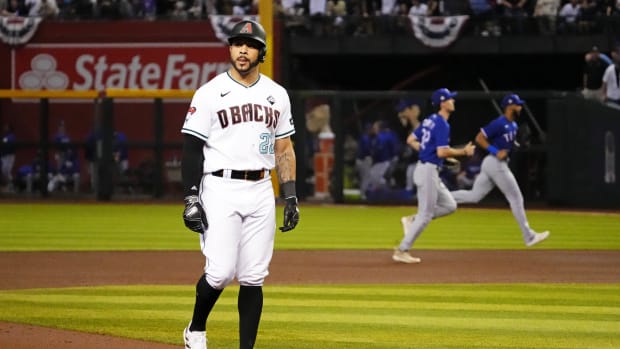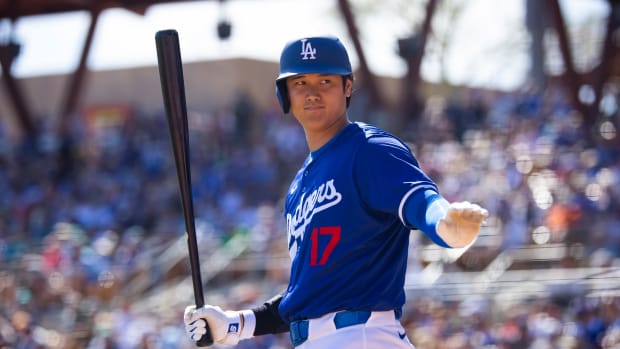Juan Soto Is Ready for the Unique Challenges of Being a Yankee
Kevin Long remembers the concern he heard on the telephone in the voice of New York Yankees general manager Brian Cashman. The Yankees were close to pulling off a December deal with the San Diego Padres to acquire outfielder Juan Soto. Long says Cashman called him as part of due diligence. He knew Long, a former Yankees hitting coach, was Soto’s hitting coach with the Washington Nationals from 2018–21, before Long joined the Philadelphia Phillies.
“He said, ‘We can’t be wrong about this one!’ ” Long says. “We’ve got to be right about this!’”
The Yankees were coming off an 82–80 season, their worst season in 31 years while missing the playoffs for the fourth time in 11 years. Recent big-name acquisitions Giancarlo Stanton, Carlos Rodón, Josh Donaldson and Frankie Montas returned a combined WAR of –1.6 while earning $84 million. The pressure was on to get this blockbuster right.
“I told him not to worry,” Long says. “Juan Soto is about as reliable as it gets in this game. He’s going to hit, he’s going to take his walks, he’s going to produce. Period.”
On Dec. 6, Cashman pulled the trigger on the deal, sending five players to San Diego to get one year of Soto—after that, the line forms to sign Soto to a free-agent contract that could challenge Shohei Ohtani’s record $46.06 million present day average annual value. The Yankees also obtained centerfielder Trent Grisham in the deal.
As trades go, it was a no-brainer. The Yankees have been desperate for left-handed power ever since they didn’t want Bryce Harper as a free agent—especially one who can help Aaron Judge see more pitches to hit. The last time a lefty posted an OPS+ of 142 for the Yankees was 11 years ago, when Long was working with Robinson Canó.
Why 142? That’s what Soto has produced in the worst of his six seasons. That’s his floor. That’s another reason why the deal was a no-brainer. Nobody in baseball history has been this reliably prolific through age 24. Check out this list:
Most Seasons OPS+ 142 or Greater Through Age 24
1. Juan Soto | 2018–23 | 6 |
2. Ty Cobb | 1907–11 | 5 |
Jimmie Foxx | 1925–32 | 5 |
Josh Gibson | 1930–36 | 5 |
Mickey Mantle | 1952–56 | 5 |
Mike Trout | 2012–16 | 5 |
There is one reason why this deal could go sideways—and it’s the exact reason people erroneously are pointing to as the reason why Soto will have a “monster” season: Yankee Stadium.
Yankee Stadium and its short porch do not help Soto. His power comes naturally toward left-centerfield because he allows the ball to get deeper than most hitters. If he starts trying to catch the ball farther out from the plate to pull the ball, the Yankees and Soto are in trouble.
“You tell Juan,” Long says, “that if I see him trying to jack the ball out to right field, he’s going to hear from me. But no way do I expect that to happen.”
Says Soto: “No, that’s not me. I’ll be all over left field, low line drives that way. That’s what I’m going to try to do. I think this stroke is what I chose when I was a little kid. Because even when I was a kid, I was able to hit the ball the other way. I never tried to pull any balls when I was a kid. Every hard-hit ball that I hit was like left-center and center. That was the way I hit my whole life.”
Pat Roessler, assistant Yankees hitting coach, says Soto has the best “barrel awareness” he has ever seen.
“Nobody I’ve seen squares the ball up like him,” Roessler says. “He doesn’t miss. You hear hitting coaches sometimes go, ‘Good swing! Good swing!’ when a guy fouls it back. A good swing is hitting the ball on the barrel of the bat. That’s what he does constantly. He works at his routine every day. The other day he had about eight people watching him, including [shortstop Anthony] Volpe. People are amazed.”

Soto arrives in the Bronx with big expectations after three consecutive All-Star appearances.
Kim Klement Neitzel/USA TODAY Sports
Yankee Stadium—old and new versions—has been known to get inside hitters’ heads because of that short porch. When the Yankees signed Jason Giambi after the ’01 season, they thought they were getting Soto-like reliability from one of the best pure hitters in baseball. With Oakland, Giambi was a .308 hitter who slugged .545 and pulled the ball 27% of the time—even better rates than Soto (.284/.524/30%). But as a Yankee, Giambi became more of a pull hitter and a worse hitter: .260 average, .521 slugging percentage and 33% pull rate.
Besides, the short porch is generally overrated for lefties. It does favor right-handed hitters who don’t have to square up a pitch for an opposite-field home run. Of the 21 homers Volpe hit last season, for instance, six were off fastballs he carved slightly over the wall in right field.
For left-handed hitters, pull-side power often means no-doubter type home runs. According to Statcast, Soto’s 35 home runs last year equate to only 27 at Yankee Stadium. Only PNC Park in Pittsburgh, with another deep left-center, would have been less favorable to Soto (26 homers) than Yankee Stadium.
“What makes Juan special is that he sees the ball longer,” Long says. “He has two more clicks than the average hitter when it comes to swing decisions.”
If Soto starts chasing pull power, which requires hitting the ball out front, he forfeits his biggest advantage.
“No, I don’t think the stadium is an issue for me,” Soto says. “I think it’s going to be better. Why? Because sometimes you get out front with an off-speed pitch and maybe those go out.
“We also have some guys in the league that pound you in. And against those guys I’m probably going to be like, ‘Okay, I’ve got to get my barrel a little bit out front.’ But nothing like I’m trying to pull the ball. I’m trying to hit the gaps, maybe the right-center gap. If I happen to pull it, that’s fine. But I never think that way, like ‘I’ve got to pull this guy.’
“Even against guys other guys think you really have to pull, I don’t like that at all. I remember this guy [Tyler] Rogers, from San Francisco. A lot of guys think like they have to pull the ball against him. I still think, I ain’t pulling. And I have had a couple of nights pulling off my front side against him, but I never think, Oh, I’ve got to pull the ball against this guy.”
Soto is one of the best young hitters the game has ever seen. Allowing a home ballpark to upset his craft would be foolish. He is at his best when he uses the entire field, with his opposite field power ranking as much more special than his pull side power:
Soto Career Hitting by Direction
| Avg. | SLG | MLB SLG Rank* | |
|---|---|---|---|
Opposite | .369 | .720 | 5th |
Middle | .355 | .593 | 20th |
Pull | .363 | .721 | 54th |
Soto’s hitting by direction is driven more by the location of the pitch than by velocity. This is an extraordinary breakdown when it comes to home runs off fastballs:
Soto Career Home Runs by Direction
| HR | FB | Pct. Off Fastball | |
|---|---|---|---|
Opposite | 48 | 32 | 66.7 |
Middle | 50 | 33 | 66 |
Pull | 62 | 41 | 66.1 |
Speaking of extraordinary, this is a home run Soto hit last year off a 3-and-2 fastball from Charlie Morton. Why is that extraordinary? Soto has seen 13,907 fastballs on the outer third of the strike zone in his career. That was the first and only one he pulled for a home run. (And one of only four such hits.)
There is one other test Soto will face as a Yankee: the daily accountability that comes with playing in New York. When the Yankees or New York Mets acquire a player, it’s another element the team must investigate, and no other market is quite like it. How will the player respond to the scrutiny? Will he get buried by a bad start?
I will never forget the day the Yankees completed the trade for Soto. I was on the MLB Network set when Johnny DiPuglia, the scout who helped the Nationals sign Soto, happened to be walking by.
“One thing about Juan,” DiPuglia told me, “is he always wanted to play in New York. He loves it.”
I ask Soto about it.
“I don’t know. I mean, I always wanted to play in D.C.,” Soto says, smiling. “That was the first thing, but definitely it was fun to play in New York. No doubt about it. Like, it was always fun to come play against the Mets. Face those guys, face the Yankees ... There’s a different vibe. There’s a different energy. You have a crowd full of people booing you and I get a lot of guys cheering you.
“They even boo you and then they go, ‘Oh, okay, you’re the man. You’re the best.’ Like, ‘I hate you, but I love you at the same time.’ You know? It’s a different kind of feeling. It’s great. It’s cool. It’s going to be fun. I think it’s going to be great.
“I don’t care about the pressure of the fans or whatever they say. I think it’s going to be more fun than pressure.”
Last season Soto was part of a San Diego team that wilted under the pressure of expectations. The Padres underachieved without clubhouse cohesiveness. “Sometimes you have one of the best teams,” Soto says, “but it never clicks. It’s just baseball.”
Expectations always are heavy for any Yankees team, particularly one that is trying to get Judge, who turns 32 next month, to his first World Series.
“He’s unbelievable,” Soto says. “The way he just handles himself and how he treats everybody. That’s insane. It’s pretty cool to be right next to him and working with him in the outfield and everything.
“This is an unbelievable group of guys. The Yankees, with the way they treat players, are the best organization in the league. That’s the only thing I hear about. And now I’m seeing it. Now I’m feeling it. They just treat players a little different than anybody else. Everybody you ask, they just talk about the Yankees and the Dodgers. And it’s a great feeling to be here.”
Soto presents little risk for the Yankees. For the trade to work for New York, it needs only a typical season from Soto, who has made greatness typical. His career OPS is .946. No Yankee left-handed hitter has reached that mark in a season since Giambi did 18 years ago. What they don’t need is Soto swinging for the short porch in Yankee Stadium.




































